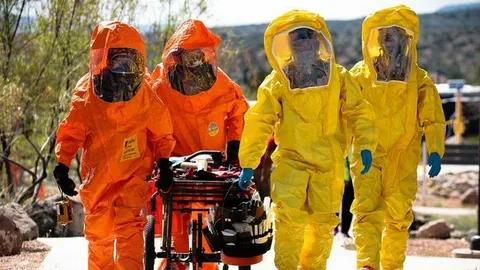If you live in or around San Pablo, California, you might have recently heard about the evacuation orders issued due to a hazardous materials situation. These orders can be alarming, especially if you’re not familiar with why they’re issued or what steps to take when you receive one. In this article, we’ll dive deep into the recent San Pablo evacuation orders, why they were necessary, what happens during such incidents, and how you can prepare for emergencies involving hazardous materials.
What Caused the San Pablo Evacuation Orders?

In early October 2024, a significant discovery of hazardous materials in a San Pablo residential area led authorities to issue evacuation orders. The Contra Costa County Fire Department, along with hazmat teams and local law enforcement, responded to the scene on Stanton Avenue, where they found a large quantity of volatile chemicals stored in a backyard shed. These materials included hundreds of containers, some of which held explosive and toxic substances. Because of the potential for fire, explosion, or toxic exposure, authorities made the decision to evacuate nearby residents as a precaution.
The affected area covered multiple blocks around the site, and residents were asked to leave their homes and seek temporary shelter. Contra Costa Community College opened its doors to accommodate evacuees, providing a safe location for residents until the area could be declared safe.
Understanding the Risks of Hazardous Materials
Hazardous materials, or hazmat, can refer to a wide range of substances that pose risks to human health or the environment. In this case, the San Pablo evacuation orders were issued due to the risk of chemical exposure, fire, and explosion. Hazardous materials incidents are handled by specialized teams who are trained to contain and neutralize dangerous substances safely.
Common types of hazardous materials include:
- Chemicals: Such as industrial solvents, pesticides, and acids.
- Explosives: Substances that can detonate under certain conditions, including some gases and volatile liquids.
- Toxins: Materials that are poisonous if inhaled, ingested, or touched.
- Flammable Liquids: Substances like gasoline or alcohol that can ignite easily.
During a hazmat incident, professionals work to assess the extent of the danger, contain any leaks or spills, and safely dispose of the materials. In San Pablo, this meant carefully removing hundreds of containers to prevent any accidental release of dangerous chemicals into the environment.
What Are Evacuation Orders and Why Are They Important?
Evacuation orders are issued by authorities when there is a significant risk to public safety. These orders may be mandatory, urging residents to leave an area immediately, or advisory, suggesting that evacuation would be in the best interest of safety. The San Pablo evacuation orders were mandatory, as the proximity of hazardous chemicals posed a direct threat to residents’ health and safety.
When evacuation orders are issued, they are done so to:
- Minimize Exposure: Hazmat situations can result in toxic fumes, explosive hazards, or contamination. Evacuating ensures that people are not exposed to these risks.
- Allow Emergency Response: By clearing the area, emergency responders have space to work and can focus on containing the hazard without worrying about public interference or risk.
- Reduce Casualties: Quick evacuation helps to prevent injuries or fatalities in case the situation escalates.
What to Do During an Evacuation Order
Knowing what to do when an evacuation order is issued can make a significant difference in your safety. Here are key steps to follow:
- Stay Informed: Evacuation orders are typically communicated through emergency alert systems, local news, social media, and sometimes even door-to-door notifications by law enforcement.
- Act Quickly: If you’re told to evacuate, leave as soon as possible. Delaying could increase your risk of exposure to harmful substances or other dangers.
- Prepare a Go-Bag: Have a bag ready with essentials such as identification, medications, water, snacks, extra clothing, important documents, and basic hygiene items.
- Plan Your Route: Use the routes recommended by emergency services. These are chosen to avoid dangerous areas and streamline evacuation efforts.
- Check on Neighbors: If you have elderly or disabled neighbors, check if they need assistance evacuating.
- Secure Your Home: If time allows, turn off utilities like gas and electricity to reduce the risk of fire or explosion in your home.
What to Expect During a Hazmat Evacuation

Hazmat evacuations can last anywhere from a few hours to several days, depending on the severity of the incident and the type of materials involved. In San Pablo, residents were displaced until it was safe to return. During this time, emergency responders worked to:
- Contain the Hazard: Specialized teams assessed the materials, removed them safely, and neutralized any immediate threats.
- Monitor Air Quality: In cases involving toxic substances, air quality monitoring is essential to ensure the area is safe for re-entry.
- Provide Updates: Local authorities will provide updates on the status of the evacuation, estimated times for re-entry, and any other necessary information.
FAQs on San Pablo Evacuation Orders
1. Are evacuation orders always mandatory?
No, evacuation orders can be either mandatory or advisory. In San Pablo’s case, the orders were mandatory due to the high risk presented by the hazardous materials.
2. What should I take if I have to evacuate quickly?
Bring essential items such as identification, medications, important documents, water, snacks, clothing, and supplies for any pets. A go-bag with these items is ideal for emergencies.
3. How will I know when it’s safe to return home?
Authorities will announce when it is safe to return home through official channels, such as news outlets and local emergency alert systems. Wait for official confirmation before re-entering the area.
4. What if I can’t evacuate due to mobility issues?
Local authorities often provide assistance for those who cannot evacuate independently. If you need help, contact emergency services immediately to arrange assistance.
5. Can I go back to check on my home before evacuation orders are lifted?
No, re-entering an area under evacuation orders is dangerous and may interfere with emergency response efforts. Wait until authorities officially declare it safe to return.
Preparing for Future Hazmat Incidents
While incidents like the San Pablo evacuation orders are rare, being prepared can make a big difference. Here’s how to stay ready for emergencies:
- Sign Up for Local Alerts: Many cities offer emergency alert systems that notify residents of hazards and evacuation orders via text or email.
- Create an Emergency Plan: Know your evacuation routes, have a go-bag ready, and make sure everyone in your household understands the plan.
- Know Your Neighbors: In emergencies, neighbors often help each other. Familiarize yourself with those around you, especially if they may need assistance.
- Stay Informed About Local Hazards: If you live near industrial areas, chemical plants, or other potential sources of hazardous materials, be aware of the types of incidents that could occur and how to respond.
Conclusion: Lessons from the San Pablo Evacuation Orders
The recent San Pablo evacuation orders are a reminder of the importance of emergency preparedness. Hazmat incidents can occur unexpectedly, but with the right information and a quick response, you can protect yourself and your loved ones. While no one wants to experience an evacuation, knowing what steps to take can ease the process and ensure you’re ready if the unexpected happens. Stay informed, have a plan, and always take evacuation orders seriously—they’re designed to keep you safe.
By understanding the risks and procedures involved in hazmat incidents, we can all be better prepared for emergencies like the San Pablo evacuation orders. Taking the time to prepare now will give you peace of mind and could even save lives in a future incident.





